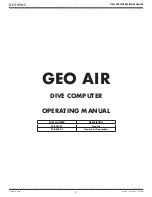
General Piston Pressure Gauge Considerations
Crossfloating
2
2-9
(
)
g
h
P
P
P
air
m
H
*
*
−
=
Where:
h
is the vertical distance between the reference plane of the Standard and the
reference plane of the DUT (Device Under Test)
air
P
i
s the density of the air
m
P
is the density of the test media
g
is the acceleration due to local gravity
L1
is the vertical distance from the mass loading location to the effective
bottom of the piston.
D
is the vertical distance from the mass loading location to the bottom of the
Hanger Mass
Note
For instances where the reference plane of the DUT is LOWER than the
reference plane of the standard, the h is a negative number and therefore
P
H
becomes a negative number.
In addition, gas lubricated piston pressure gauge calculations should account for the fact
that the pressure gradient mentioned in the preceding paragraph changes as system
pressure is changed. This is because the specific gravity of gas varies as a function of
pressure, not remaining approximately constant, as does a hydraulic fluid.
For good work, a piston pressure gauge should be provided with an index mark for
associating the reference of the piston with other planes of interest within a system. The
design of this index will vary with the design and manufacture of the instrument, it may
be in the form or an index rod with scribed lines on it, an index groove on the column of
the instrument, or, other type of fixed indicator. Not only does the mark serve to establish
fixed values of pressure differences through a system, it indicates a position of the piston
with respect to the cylinder at which calibration and subsequent use should be conducted.
If the piston is tapered, it is important to maintain a uniform float position for both
calibration and use. This Position is referred to as the “Mid-Float” position as it
represents the middle of the calibrated range of the Piston/Cylinder.
In normal operation, the system is pressurized until the piston is in a floating position
slightly above the index mark. After a period of time, the piston and its load will sink to
the line at which time the conditions within the system are stable. If there is a question as
to the error that may be produced by accepting a float position that is too high or too low,
the error will be equivalent to a fluid head of the same height as the error in the float
position. This statement assumes that the piston is uniform in area over this length.
Crossfloating
It was mentioned earlier that some piston pressure gauges must be calibrated against a
standard gauge. In the jargon of the laboratory, this process is called crossfloating. When
crossfloating one gauge against another, the two are connected together and brought to a
common balance at various pressures. The balancing operation is identical with that
employed on an equal-arm balance where the mass of one object is compared to another.
In each instance the operator must decide when the balance is complete. In a crossfloat,
the two gauges are considered to be in balance when the sink rate of each is normal for
that particular pressure. At this condition there is no pressure drop in the connecting line,
and consequently no movement of the pressure medium. The condition can be difficult to
recognize, particularly if there is no means of amplification in the method of observing.
The precision of the comparison will depend directly upon the ability of the operator to
judge the degree to which the balance is complete. This procedure is repeated for several
Summary of Contents for RUSKA 2465A-754
Page 5: ...iii List of Tables Table Title Page 2 1 Symbols 2 2 ...
Page 6: ...RUSKA 2465A 754 Users Manual iv ...
Page 8: ...RUSKA 2465A 754 Users Manual vi ...
Page 12: ...RUSKA 2465A 754 Users Manual 1 4 ...
Page 26: ...RUSKA 2456A 754 Users Manual 3 4 ...
Page 54: ...RUSKA 2465A 754 Users Manual 6 14 ...
Page 64: ...RUSKA 2465A 754 Users Manual A 10 ...
Page 66: ...RUSKA 2465A 754 Users Manual A 12 ...
Page 68: ...RUSKA 2465A 754 Users Manual B 2 glg32 bmp Figure B 1 P C ASSY LR CAL D ...
Page 70: ...RUSKA 2465A 754 Users Manual B 4 glg34 bmp Figure B 3 P C ASSY W O CLEANING KIT ...
Page 72: ...RUSKA 2465A 754 Users Manual B 6 glg36 bmp Figure B 5 PC ASSY MHR W O CLEANING KIT ...
Page 74: ...RUSKA 2465A 754 Users Manual B 8 glg38 bmp Figure B 7 P C ASSY HR CAL D W O CLEANING KIT ...
Page 80: ...RUSKA 2465A 754 Users Manual B 14 glg43 bmp Figure B 12 2465A 23 ...
















































